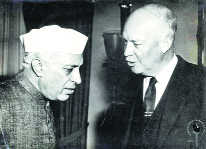Dwight D Eisenhower: 1959
He was the first American President to visit India 12 years after Independence at the fag end of his second term. His India visit was part of a 11-nation tour and meant to rustle up allies in the Cold War. As was the tradition those days, Prime Minister Jawaharlal Nehru and his Cabinet turned up at the airport to receive him. One of the ministers present there was Indira Gandhi. However, Eisenhower was unable to give India any solace vis-à-vis China after the armies had clashed twice that year in what was to be the precursor to the Sino-India war of 1962. Eisenhower had already provided generous military assistance to Pakistan, but his two-term presidency also saw a substantial increase in monetary and food aid to India. His administration also funded the Indus Waters Agreement that led to India and Pakistan achieving unanimity on sharing of water of six common rivers. Eisenhower also visited Agra during the tour that was remarkable for the lack of security.
Richard Nixon: 1969
The Indo-US ties had deteriorated during the decade and this was reflected in the shortest-ever visit to India by a US President — a mere 23 hours. Richard Nixon visited India just six months after becoming President but he was also the first US President to have visited the country twice earlier, on both occasions as a private citizen. His personal equation with Prime Minister Indira Gandhi had already been defined during a meeting two years earlier when both sides went through the motions. By the time he arrived, Nixon was not too keen to be seen as close to India as he was using Pakistan as a conduit
for getting close to China. Another contributory factor was Indira Gandhi’s accent on nationalisation. Like Eisenhower before him, this was a multi-country tour — Nixon visited Pakistan besides six other countries. Though he addressed the customary state banquet, Nixon wasn’t asked to address the Indian Parliament.
Jimmy Carter: 1978
After the near-collapse in ties during the Indira Gandhi-Richard Nixon period, Jimmy Carter resuscitated the relationship somewhat, thanks to his India connection. His mother Lillian Carter had been a frequent guest at a village headman’s house during her Peace Corps volunteer days in India. Accompanied by wife Rosalynn, Carter went to the Haryana village Daulatpuri and presented the headman with a TV set, a technological marvel in those days. The village was later named Carterpuri. Carter also addressed Parliament but strategic ties with India were cold despite a change in government. This was because his administration was finalising the Nuclear Nonproliferation Act that ended all assistance to countries which had not signed the Nuclear Non-Proliferation Treaty (NPT). Still incensed over India’s 1974 nuclear tests, Carter was caught telling his advisers that on return to the US, he must deliver a “cold and blunt message” to India.
Bill Clinton: 2000
This visit took place after the longest gap of 22 years but was the most transformative. As Bill Clinton later said, it was meant to lay the foundations of a solid relationship with India. In the longest visit by a US President, he toured five cities — power centre Delhi, tourist destinations Agra and Jaipur, the financial hub Mumbai and the emerging IT powerhouse Hyderabad. Arriving in the wake of the Monika Lewinsky scandal, Clinton adopted a smart media strategy of taking along his daughter Chelsea. In the end, it did not matter because MPs fell over each other to shake his hand after he had addressed a Joint Session of both Houses of Parliament. The eve of his visit saw a score of Sikhs being massacred in a Jammu and Kashmir village and Clinton held Pakistan responsible for the violence in Kashmir, though Islamabad was the next stop where he spent just five hours, arriving not on Air Force One but using a decoy plane instead.
George W Bush: 2006
By the time George Bush came to India, it didn’t matter that he spent just 60 hours, the second shortest trip after that of Richard Nixon. Both countries were on the path towards strategic convergence with a Defence Framework Agreement and had set the stage for a nuclear deal after India agreed to separation of its civilian and military nuclear facilities. By then, the first US military equipment had arrived in India after decades of mutual reticence to do business in sensitive areas. With his country bleeding from the two military commitments, Bush, delivering an address from the ramparts of mystically-lit Purana Qila, called upon India to further open its markets to American goods and investment. The Left was supporting the ruling coalition, a factor contributing to the US President not addressing Parliament. The US President also visited Pakistan and unlike Clinton chose to stay overnight — at the US Ambassador’s fortified residence.
Barack Obama: 2010
This was the shortest gap between two presidential visits to India with Obama landing in India on Diwali. By this time, the US Administration had de-hyphenated ties with India and Pakistan. White House had decided to name Richard Holbrooke as the envoy only for Afghanistan-Pakistan and Obama skipped Pakistan as a destination. He gladdened Indian hearts by ending his speech in Parliament with a “Jai Hind” and for the first time a US President seemed agreeable to a permanent Indian presence in the United Nations Security Council. In Mumbai, he announced the removal of many sensitive items from the export control list. Like Bush, Obama pitched for greater trade and called for lower barriers in agriculture, telecom and retail. However, he could not unlock the nuclear tangle, nor was he able to persuade India to ink sensitive military cooperation deals but defence trade had taken off by then. — Compiled by Sandeep Dikshit
Unlock Exclusive Insights with The Tribune Premium
Take your experience further with Premium access.
Thought-provoking Opinions, Expert Analysis, In-depth Insights and other Member Only Benefits
Already a Member? Sign In Now










